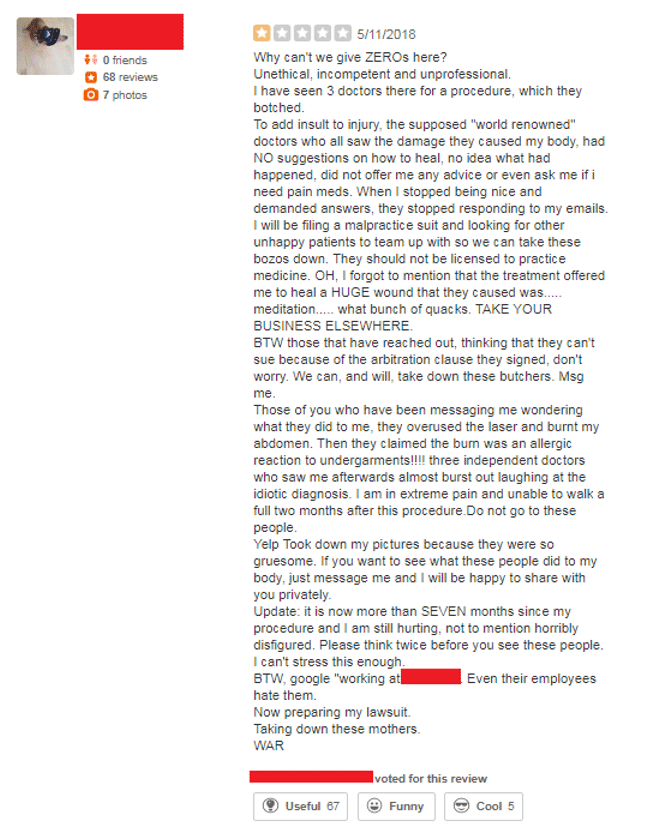The Challenge:
An unhappy ex-patient (who happens to be an attorney) threatened legal action against a surgeon. This ex-patient attempted to coerce other patients into posting inciting reviews on Yelp. The review not only promised legal action but solicited others to participate.
The Remedy:
Due to the advanced age of the content, eMerit communication specialists advised the review to be left alone. Engaging with the content so long after its publication risked motivating the author to resume threats.
The Explanation:
This case study emerged when an unhappy patient posted an inciting review on Yelp. This event took place on 5/11/2018. We’ve included an image of the review below with personal information redacted.

An employee of the practice contacted us and requested help removing the review. This request was received 7/1/2019. A little over one year after the inciting review was published. The age of the review is an important detail – we’ll return to it later.
Our client wanted the review removed if possible. We evaluated the content and found no explicit Terms of Service violations or Content Guideline violations. The absence of an explicit violation made the chances of removing the content low. Arguments for its removal would not meet Yelp’s threshold.
Click here to read Yelp’s current content guidelines. We’ve summarized the salient points below…
Posts cannot contain inappropriate content. Profanity is acceptable. Hate speech and threats of violence are not.
Posts cannot contain conflicts of interest.
Posts cannot contain advertisements.
Posts must include information that is relevant to a consumer’s experience. A review that is critical of wait times is acceptable. A review lambasting the practice’s employment policies is not.
Posts cannot advertise private information – names, addresses, phone numbers, etc.
Posts must contain original content. Content copied from other sites is prohibited.
Posts cannot be used as tools of extortion. For example, if the author demands payment in exchange for removing critical content, this is a content violation.
If the content violates any of the standards described above, you have a case for its removal. We are regularly able to flag reviews that contain violations of Yelp’s terms of use. They are frequently successfully removed. In this example, there were no violations. But even if there were several violations, flagging the content for removal isn’t always the best move.
Before flagging the content for removal, you must ask yourself a critical question: Will flagging the content for removal make my situation better? Or worse?
Consider the age of the content and the level of engagement. In this example, the threatening review is one year old. And no Yelp users responded to the author’s rallying cry to sue the surgeon. The review was like a fossil – old, dusty, and buried.
So, why not flag the content anyway? What does the practice have to lose? Quite a bit. When a Yelp review is flagged for removal, the author of the review is notified. We predicted flagging the content would motivate the author to revisit it – which may catapult the content back to the top of the practice’s Yelp page. A bad outcome.
In this situation, our recommendation, while not glamorous, was effective. Do nothing. Don’t resurrect the conflict by attempting to remove the troubling review. Let sleeping dogs lies.
The Takeaway:
If you’re navigating a negative review, consider these elements…
How old is it?
How visible is it?
How much is the public engaging with it?
If the content is old, difficult to access, and not a node of conversation, the strategic decision is to leave it alone. Engaging old reviews risks opening old wounds. If you are considering how to respond to a unfavorable review, consult with us first. We can guide you towards a favorable outcome. Use the tools below to get in touch.




